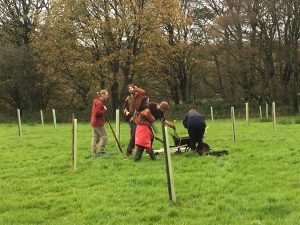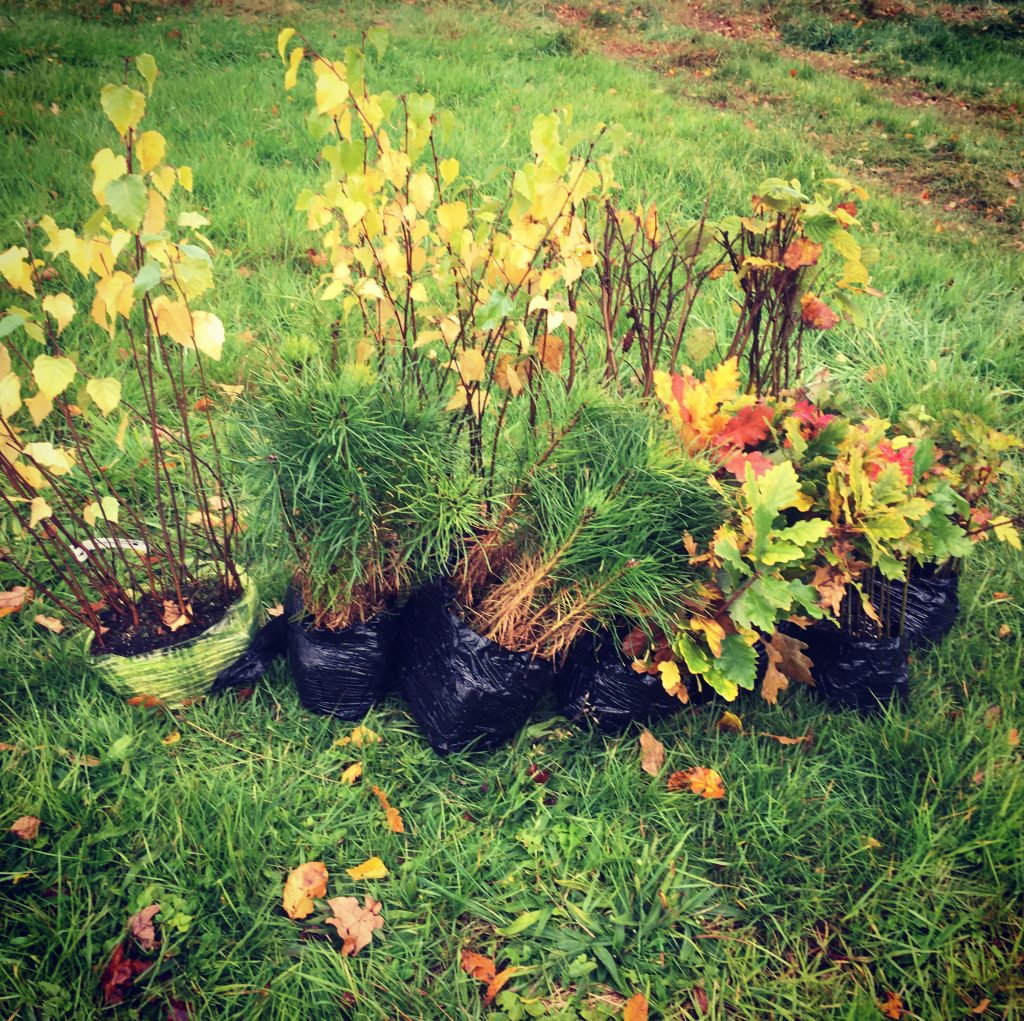I’m on my knees in a muddy field in Scotland, planting tiny trees. Digging, pushing their little plugs of root into the heavy clay soil, closing the ground around them, driving in a stake and fitting a tubular protector to give them the best chance of a future. I won’t live to see these trees grow to maturity. It takes thousands of years to grow a forest and this is the beginning. I feel more optimistic than I have for many months.
It’s been a difficult time for optimism. A daily scan of news media is scary and depressing, a process of mentally filing each item into brain folders titled either ‘We’re Fucked’ or ‘We’re Totally Fucked’. Some may go into subfolders with names like ‘What The Actual Fuck?’, ‘Wake Up You Fuckwits’, ‘Evil Fucker(s)’and ‘We Deserve the Extreme Tornado of Fuckery Coming Down Upon Us’.
At the start of lockdown back in March, that green time of Spring and unusually persistent sunshine, that time when we did our neighbours’ shopping for them instead of being told to shop our neighbours, when the air quality in cities cleared, birdsong was louder and wildlife seemed to come closer – then, people whispered There Could be a Better World to Come. Now we know that there could also be a much, much worse world just around the corner, a world we may wake up to on November 4th*. (*update – we seem to have averted the worst for now, but may not have yet woken up…)
For those who have been, for a few years, turning to face our environmental crisis as fully as we can without being turned to stone, who have been finding ways to live with difficult truths, to understand our own mortality and that of our species as an Awfully Big Adventure that is nonetheless insignificant in the span of deep time and mass extinctions – for us the work around mapping a possible, re-imaged optimism had already started. It is work which takes each of the elements of psychological response to the impending end of life as we know it and reconfigures them in a way which enables us to keep walking. Grief, anxiety, terror, sadness, rage, impotence, despair, each is an emotional muscle which transfers weight from foot to foot, somehow supporting a forward momentum which keeps us just ahead of collapse. And whilst we walk, we are trying to change our boots, sodden with tears and worn out from the jagged stones of daily bad news, for more robust, dry footwear that will carry us through the toxic mud and over the rocks to a place where we can one day walk barefoot. A place of hope, which has nothing to do with the expectation that technology will save us, or that humankind will come to its senses in time to avert catastrophe, or that Trump and Bolsonaro and Johnson and Modhi and Orban will be sucked up to The Land of Oz by a giant twister and squashed under a falling Kansas house with only their lifeless stripy legs poking out to remind us of the clown-dictator-shitshow we nearly descended into … no, our brand of optimism is not predicated on fantasy fixes. It recognises that we are facing not the end of this world but almost certainly the end of this civilisation. And our hope is that we can face that near-certainty equipped with the resilience to hold on to those things that are truly important to humanity as part of nature; the humility to let go of those things that rupture us from the non-human; and the sagacity to recognise one from the other.
Within that configuration of knowing, the current pandemic is simply a gentle warning from the future. Which is not to understate the individual human losses, family grievings, hardships and heartbreaks that are the stories of our COVID times. Not to under-estimate the sacrifices of communities and nations in closing their societies and economies to save lives. Just that this virus is one part of a bigger story, one symptom of the gargantuan and ever-widening rift between our industrial structures and the planet’s natural life systems: the movement of disease organisms from the non-human habitats we have destroyed to our own species.

The distant Galloway hills have emerged from the lifting cloud and in the west some slivers of almost-blue-silver brighten the sky. Autumn colours are toned up by light, tweaking the warm gold, yellow, tawny, khaki, orange palette of mature trees surrounding our field and the kindergarten woodland wrapped in green plastic pipe to guard against deer. There are ten of us and we are close to completing our first wave of planting: one hundred and fifty pine, oak, birch, hazel and hawthorne. Next month we will plant a further five hundred oak, yew and holly, in the spring apple, plum, sweet chestnut maybe. And this evening we’ll sit around a firepit sharing drink and food and talking about tears shed at the latest David Attenborough series.
Eighteen months ago I made some big decisions about changes I was going to make in life. That included my sons and me starting to look at parcels of land to buy – a legacy project, a future haven for deep adaptation as times get darker, a vision for how we start to build a community on the land around growing, rewilding, creativity, learning, holding space. With music, dancing, nights around the fire, storytelling, myths, the past and the future held in the present moment, a stage in making a somewhere that generations after us might survive and thrive as a different way to be human inside nature.
Initially we started looking at woods – I have always loved the idea of living in a forest – and we saw some amazing places in Scotland and Wales. But, it occurred to us, if we get a wood we’ll have to cut down trees to create living and growing space. When we saw our pasture field, a few miles north of Dumfries, we knew that the answer was to plant trees. It’s a beautiful space as it is, edged by large oaks, hazel, birch and beeches and it will change as the trees we have planted grow, redefine into areas and thickets, clearings and groves. Part of it will just do its own thing and we’ll have no idea how it will be in twenty, thirty years’ time. By then I’ll be an ancient crone sitting in my yurt dispensing babbling incoherences or gnomic wisdom. Probably the former.

This is not my project – I am simply helping it to start. My sons and their friends and their children and their children’s children will take this forward in their own image which will hopefully be an image closer to the natural world we inhabit than the exceptionalist industrial psyche that believes modern human-kind with its extraction, destruction, enslavement, burning, pride and cruelty, is the pinnacle of all life on earth.
Yesterday in the autumn sunlight I hugged a huge oak at the edge of the field, just beside the gate from the lane. I felt the life force of the great trunk with its rough, lined bark and heard the sound of its branches moving with the wind above me. In my mind I asked the oak to stand guard over all the small trees we were going to plant, to help them survive and grow. I heard voices in the lane, two young mothers out on a walk with pushchairs, and stepped away from my oak feeling a bit daft.
When they had passed I put my hand on the tree again. It felt like a prayer.

